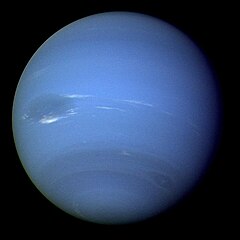Neptunus
Dari Wikipedia bahasa Indonesia, ensiklopedia bebas
 Neptunus dari wahana Voyager 2 | |||||||||||||||||||||
| Penemuan | |||||||||||||||||||||
|---|---|---|---|---|---|---|---|---|---|---|---|---|---|---|---|---|---|---|---|---|---|
| Penemu | Urbain Le Verrier John Couch Adams Johann Galle | ||||||||||||||||||||
| Tanggal ditemukan | 23 September 1846[1] | ||||||||||||||||||||
| Penamaan | |||||||||||||||||||||
| Adjektif | Neptunian | ||||||||||||||||||||
| Epos J2000 | |||||||||||||||||||||
| Aphelion | 4.553.946.490 km 30,44125206 SA | ||||||||||||||||||||
| Perihelion | 4.452.940.833 km 29,76607095 SA | ||||||||||||||||||||
| Sumbu semi-mayor | 4.503.443.661 km 30,10366151 SA | ||||||||||||||||||||
| Eksentrisitas | 0,011214269 | ||||||||||||||||||||
| Periode orbit | 60.190 hari 164,79 tahun | ||||||||||||||||||||
| Periode sinodis | 367.49 day[4] | ||||||||||||||||||||
| Kecepatan orbit rata-rata | 5,43 km/s[4] | ||||||||||||||||||||
| Anomali rata-rata | 267,767281° | ||||||||||||||||||||
| Inklinasi | 1,767975° ke Ekliptika 6,43° ke ekuator Matahari 0,72° ke bidang Invariabel[5] | ||||||||||||||||||||
| Bujur node menaik | 131,794310° | ||||||||||||||||||||
| Argumen perihelion | 265,646853° | ||||||||||||||||||||
| Satelit | 13 | ||||||||||||||||||||
| Ciri-ciri fisik | |||||||||||||||||||||
| Jari-jari khatulistiwa | 24.764 ± 15 km[6][7] 3,883 Bumi | ||||||||||||||||||||
| Jari-jari kutub | 24.341 ± 30 km[6][7] 3,829 Bumi | ||||||||||||||||||||
| Kepepatan | 0,0171 ± 0,0013 | ||||||||||||||||||||
| Luas permukaan | 7,6408×109 km²[7] 14,98 Bumi | ||||||||||||||||||||
| Volume | 6,254×1013 km³[4][7] 57,74 Bumi | ||||||||||||||||||||
| Massa | 1,0243×1026 kg[4] 17,147 Bumi | ||||||||||||||||||||
| Kepadatan rata-rata | 1,638 g/cm³[4][7] | ||||||||||||||||||||
| Gravitasi permukaan di khatulistiwa | 11.15 m/s²[4][7] 1.14 g | ||||||||||||||||||||
| Kecepatan lepas | 23,5 km/s[4][7] | ||||||||||||||||||||
| Hari sideris | 0,6713 hari[4] 16 j 6 men 36 d | ||||||||||||||||||||
| Kecepatan rotasi | 2,68 km/det 9,660 km/jam | ||||||||||||||||||||
| Kemiringan sumbu | 28,32°[4] | ||||||||||||||||||||
| Asensio rekta bagi kutub utara | 19j 57m 20d[6] | ||||||||||||||||||||
| Deklinasi | 42,950°[6] | ||||||||||||||||||||
| Albedo | 0,290 (terikat) 0,41 (geometrik)[4] | ||||||||||||||||||||
| Suhu permukaan level 1 bar 0,1 bar (10 kPa) |
| ||||||||||||||||||||
| Magnitudo tampak | 8,0 sampai 7,78[4] | ||||||||||||||||||||
| Ukuran sudut | 2,2″–2.4″[4] | ||||||||||||||||||||
| Atmosfer[4] | |||||||||||||||||||||
| Tinggi skala | 19,7 ± 0,6 km | ||||||||||||||||||||
| Komposisi |
| ||||||||||||||||||||
Neptunus memiliki jarak rata-rata dengan Matahari sebesar 4.450 juta km. Neptunus memiliki diameter mencapai 49.530 km dan memiliki massa 17,2 massa Bumi. Periode rotasi planet ini adalah 16,1 jam, sedangkan periode revolusi adalah 164,8 tahun. Bentuk planet ini mirip dengan Bulan dengan permukaan terdapat lapisan tipis silikat. Komposisi penyusun planet ini adalah besi dan unsur berat lainnya. Planet Neptunus memiliki 8 buah satelit, di antaranya Triton, Proteus, Nereid dan Larissa.
Rujukan
- ^ Hamilton, Calvin J. (August 4, 2001). "Neptune". Views of the Solar System. http://www.solarviews.com/eng/neptune.htm. Diakses pada 13 Agustus 2007.
- ^ Yeomans, Donald K. (July 13, 2006). "HORIZONS System". NASA JPL. http://ssd.jpl.nasa.gov/?horizons. Diakses pada 8 Agustus 2007.—At the site, go to the "web interface" then select "Ephemeris Type: ELEMENTS", "Target Body: Neptune Barycenter" and "Center: Sun".
- ^ Orbital elements refer to the barycentre of the Neptune system, and are the instantaneous osculating values at the precise J2000 epoch. Barycentre quantities are given because, in contrast to the planetary centre, they do not experience appreciable changes on a day-to-day basis from to the motion of the moons.
- ^ a b c d e f g h i j k l m n o Williams, David R. (September 1, 2004). "Neptune Fact Sheet". NASA. http://nssdc.gsfc.nasa.gov/planetary/factsheet/neptunefact.html. Diakses pada 14 Agustus 2007.
- ^ "The MeanPlane (Invariable plane) of the Solar System passing through the barycenter". 3 April 2009. http://home.comcast.net/~kpheider/MeanPlane.gif. Diakses pada 10 April 2009. (produced with Solex 10 written by Aldo Vitagliano; see also Invariable plane)
- ^ a b c d P. Kenneth, Seidelmann (2007). "Report of the IAU/IAGWorking Group on cartographic coordinates and rotational elements". Celestial Mechanics and Dynamical Astronomy (Springer Netherlands) 90: 155–180. doi:. http://adsabs.harvard.edu/doi/10.1007/s10569-007-9072-y. Diakses pada 7 Maret 2008.
- ^ a b c d e f g Refers to the level of 1 bar (100 kPa) atmospheric pressure

No comments:
Post a Comment